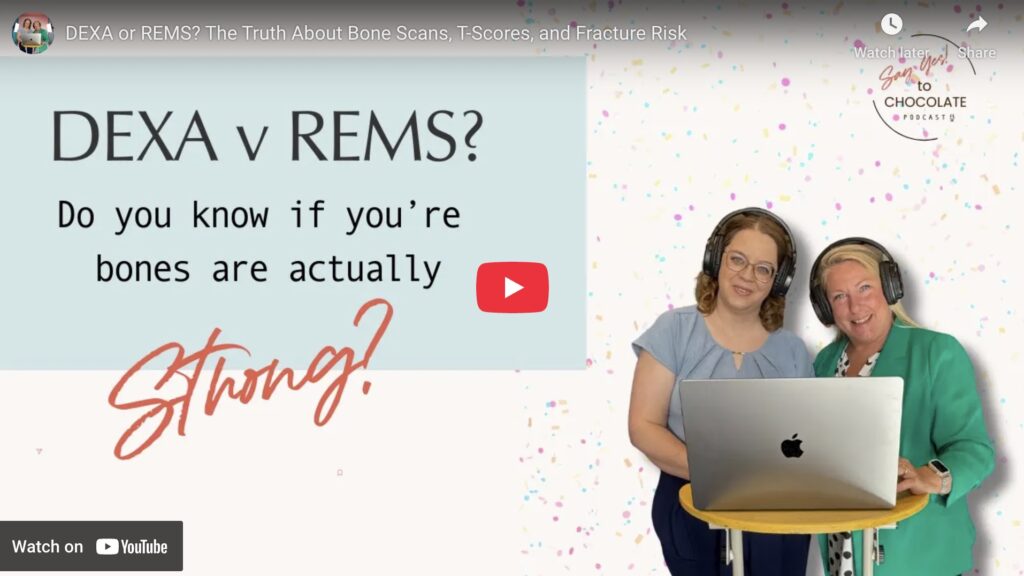DEXA vs. REMS: Which Bone Scan Tells You the Whole Story?
Have you heard of a DEXA scan? It’s been the gold standard for decades when it comes to diagnosing bone conditions such as osteopenia and osteoporosis. But here’s the truth: while DEXA can be helpful, it doesn’t always give you the whole picture of your bone strength.
That’s where a newer technology called REMS (Radiofrequency Echographic Multi Spectrometry) comes in—an ultrasound-based scan that looks beyond density to assess bone quality.
In this episode of Say Yes! to Chocolate, Dr. Becky and Sara break down the key differences between the traditional DEXA scan and the newer REMS technology—and why understanding both could change the way you think about bone health.
What You’ll Learn in This Episode
✅ What a DEXA scan actually measures (and why it can miss hidden risks)
✅ How REMS technology goes beyond density to assess bone quality
✅ The biggest limitations of DEXA (including why your results may vary over time)
✅ Why REMS can offer more real-time, detailed insights into bone remodeling
✅ What your scans can and can’t tell you about fracture risk and overall bone strength
🎧 Listen to the full episode:
🎥 Watch the full episode:
Quick Timeline of the Episode
-
00:00 Introduction to bone scans
-
00:57 Understanding DEXA scans
-
06:05 Limitations of DEXA scans
-
10:24 Introducing REMS technology
-
13:31 Comparing DEXA and REMS
-
16:40 Conclusion and action items
Why This Matters
If you’ve ever looked at your T-score and felt confused—or even scared—you’re not alone. Numbers on a scan can feel intimidating, but they don’t always tell the full story. This conversation will help you:
-
Cut through the medical jargon.
-
Understand what your scans really mean.
-
Ask better questions at your next doctor’s visit.
-
Feel empowered (not fearful) about your bone health.
And yes…we make sure to keep things clear, science-backed, and sprinkled with humor—because wellness should feel doable, not overwhelming.
DEXA vs REMS: Key Differences in Bone Density Testing
-
DEXA: density only, snapshot in time, gold standard in U.S.
-
REMS: density + quality, repeatable sooner, fuller bone health picture.
-
Why REMS may detect issues earlier and guide treatment better.
Bone Density vs. Bone Quality: Why Both Matter
-
Density = thickness and strength of bone shell.
-
Quality = flexibility, shock absorption, fracture resistance.
-
Real fracture risk depends on both.
How Often Should You Get a Bone Density Test?
-
DEXA: every 2–3 years for meaningful results.
-
REMS: can be done more frequently to monitor lifestyle or medication changes.
-
Why more frequent feedback can help you pivot sooner.
Which Test Is Best for Osteoporosis Prevention?
-
DEXA is still the gold standard in the U.S. (what most providers use).
-
REMS offers new, valuable insights—especially for women who want real-time tracking.
-
Best approach may be combining both, when available.
🎁 Free Resource
We put together a one-page cheat sheet comparing DEXA vs. REMS. It shows you exactly:
-
What each test measures
-
What each test misses
-
When you should ask for one over the other
👉 Grab your free DEXA vs. REMS Cheat Sheet here.
Research Links
For those who want to go deeper, here are a few of the studies and resources we reference:
Listen & Subscribe
🎧 Listen to the full episode on the Say Yes! to Chocolate podcast: [Apple Podcasts] | [Spotify] | [YouTube].
✨ Ready for more? Join our email list for weekly wellness tips you’ll actually look forward to.
Bottom line: DEXA is still the standard in the U.S., but REMS is a powerful new option that gives a fuller, faster, and more reliable view of how your bones are really doing. Knowing the difference helps you take charge of your bone health with confidence.
Say yes to better bones. Say yes to chocolate. 🍫💛

+ show Comments
- Hide Comments
add a comment